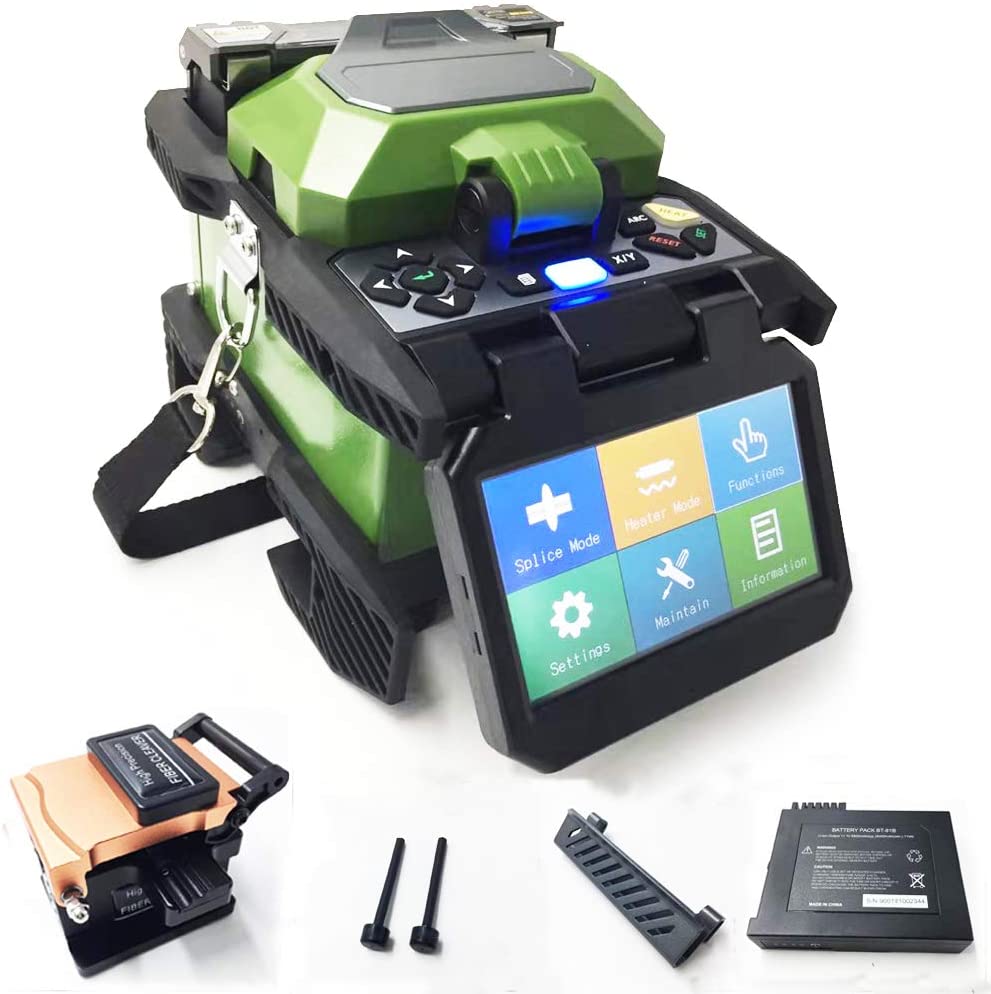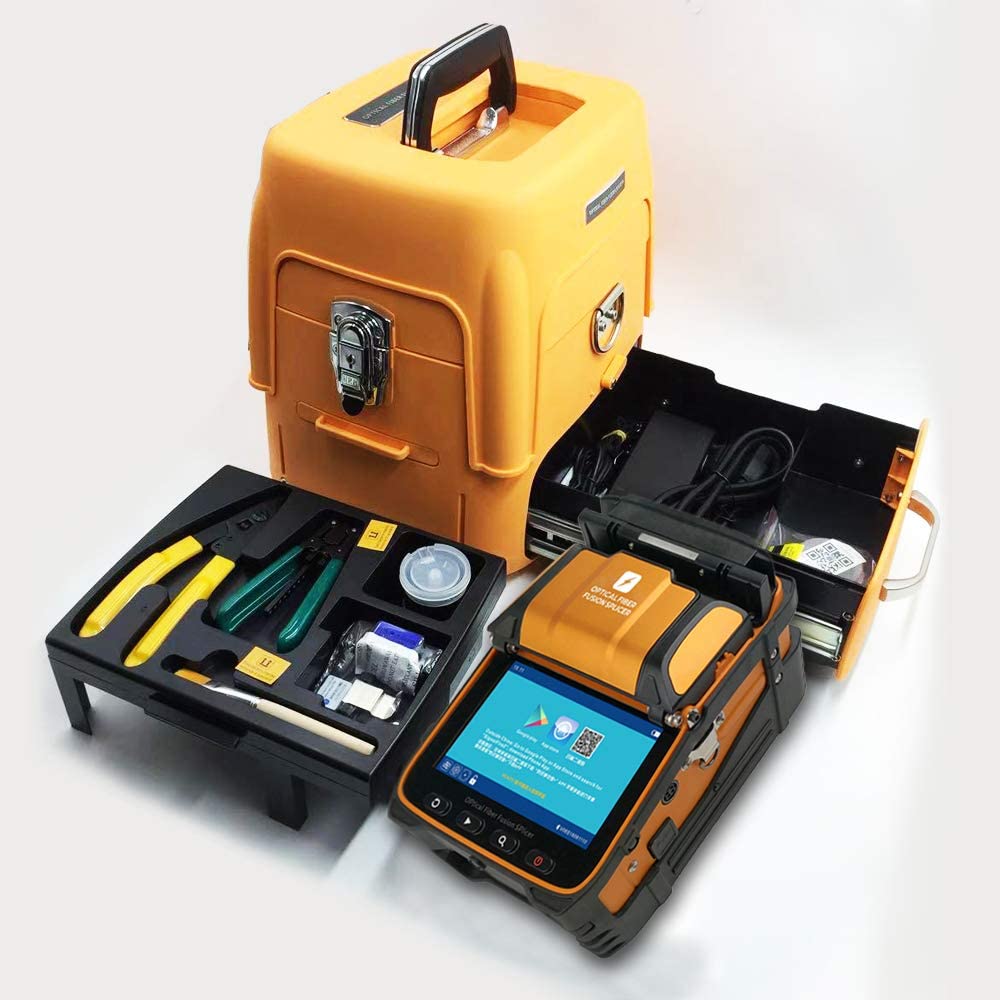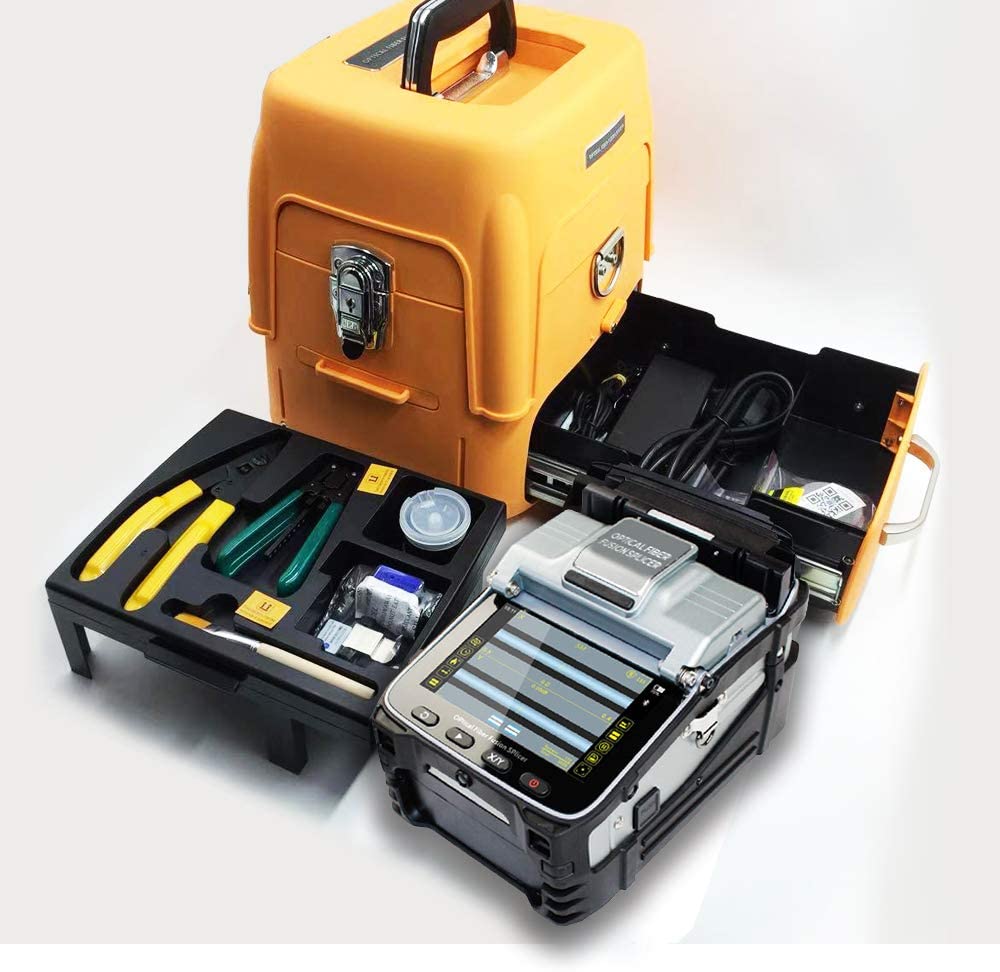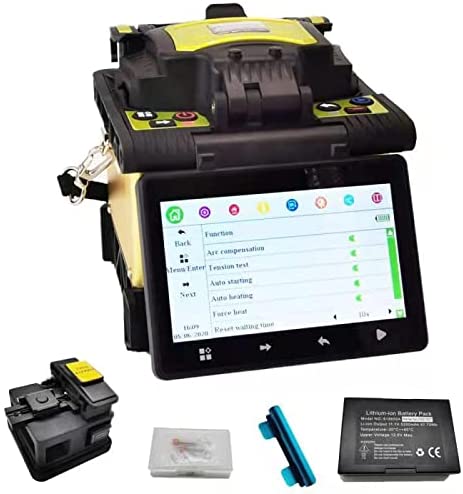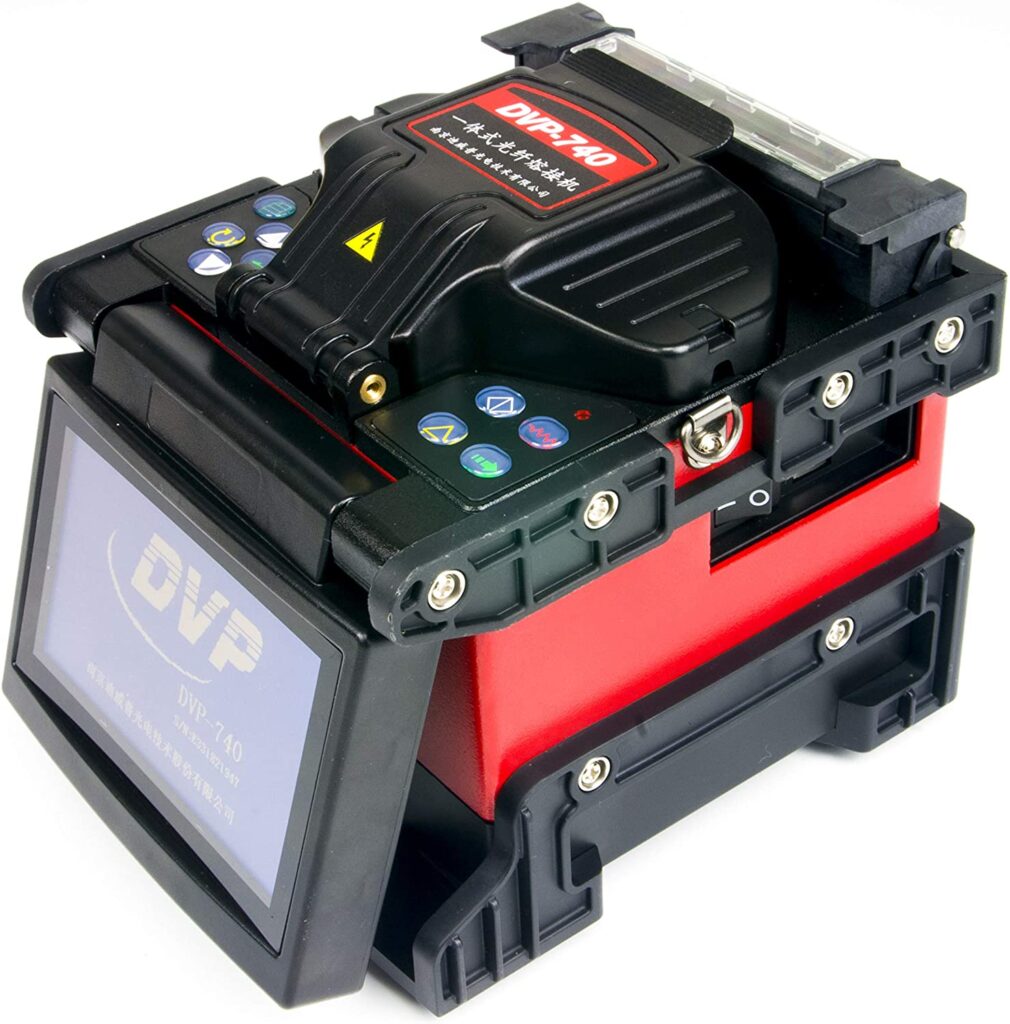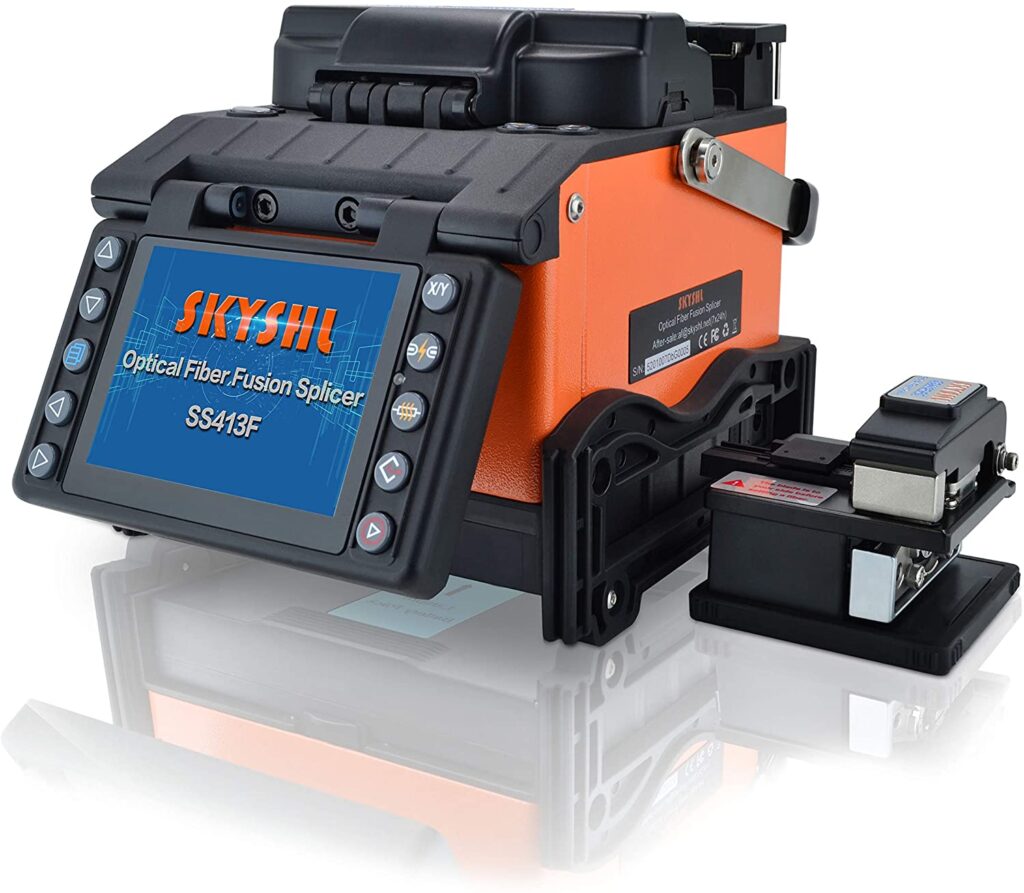Fusion splicing is the operation of connecting two optical fibers in an end-to-end fashion. A fiber fusion splicer is used to fuse two fibers in a way that light passing through the fibers is not reflected or scattered back by the splice. So, the splice and region nearby it are nearly as sturdy as the intact fibers. Usually, the source of heat is an electric arc, however, it can be a gas flame or a laser, or a tungsten filament across which current passes.
What Is Fiber Fusion Splicer?
A fiber fusion splicer is an apparatus that utilizes high precision propulsion configuration to bring two fibers to come closer to each other. An electric arc is used to melt those two optical fibers together at their ends, to create a single long fiber. The process of welding two optical fibers is called fiber fusion splicing. Currently, fiber fusion splicing is the most widespread type of splicing adopted in fiber optic production. It boasts the lowest reflection while connecting two sections of fiber.
The optic fiber ends are equipped, sliced, and positioned in alignment fixtures over the fusion splicer. With the press of a button, these optic fiber ends are warmed with electrodes, conveyed together, and fused. You can either choose the factory recommended settings or set the splicing parameters as you want. It is always better to first get acquainted with different optic fiber fusion splicers and then choose the suitable optic fiber fusion splicer for your needs. With this review, you can now find it easy on picking the best fiber fusion splicer in 2024 from the below section.
List of The Best Fiber Fusion Splicer
Check out the thorough reviews of the best fiber fusion splicer in 2024 below.
1. D YEDEMC SM&MM FTTH Fiber Fusion Splicer AI-8C
D YEDEMC fiber fusion splicer is presently one of the speediest optic fiber splicing machines prevalent in the market. This aspect makes it the best fiber fusion splicer on the list. It boasts fast response and uses an industrial quad-core CPU that offers fast splicing speed.
It is an AI-8C optic fiber fusion splicer that implements cutting-edge core alignment technology. This along with six motors and the auto focus method makes it a new generation of a fiber fusion splicer. You can use it for applications like security monitoring, FTTH project, trunk manufacture of medium and short distance, and many other fiber cable splicing projects.
The entire user operation is easy and intuitive with the 5-inch display screen that has 800 x 480 pixels resolution. Focus magnification of up to 300 times makes it extremely simple to see the fiber through naked eyes. The core alignment splicing takes 5 seconds and the heating time is 16 seconds. Compared to typical splicing machines, the work efficiency is increased by 50%.
Under rigorous testing, the overall performance is excellent. The toolbox is tiny yet durable. You can easily carry it along for ease of setup. The list of languages supported is English, Spanish, French, Polish, Portuguese, Russian, Arabic, etc.
Key Features
- The 3-in-1 fiber holder is suitable for MM, SM, pigtail, bare fiber, multi-fiber, and rubber-insulated cable.
- The splice loss for MM, SM, and DS/NZDS fibers are respectively 0.01 dB, 0.025 dB, and 0.04 dB.
- The cladding diameter is 80-150μm and the coating diameter is 100-1000μm.
- Fiber cleave length for coating less than 250µm is 8-16 mm and that for coating less than 250-1000µm is 16 mm.
- With 6 motors, the core-to-core splicing gets accomplished in 6 seconds.
- The splicing is quite easy to operate through the phone app. This app lets you learn different operations and also connects to the machine for synchronizing the update.
Pros And Cons
2. D YEDEMC SM&MM Optical Fiber Fusion Splicer YD-4106
This YD-4106 model fiber fusion splicer kit employs the industrial-grade CPU+FPGA configuration of a high-performance HD optical fiber microscope. With the use of the high-speed motor, splicing is carried out efficiently. Typically, this optic fiber splicer is used for telecommunication, optical fiber cable engineering, PON/FTTx networks, etc.
The optic fiber fusion splicing gets completed in 7 seconds. The inclusion of aluminum-magnesium alloy makes this splicer quite durable. The heating time is 18 seconds. The manufacturer designed it for splicing various optical fibers like MM, SM, bare fiber, rubber-insulated, pigtail, and multi-fiber cables.
Accessories packed along are a fiber cleaver, a fiber stripper, an AC adaptor, spare electrodes, a cooling tray, a charger, a battery, a yellow toolbox, ad rubber-insulated wire stripping pliers.
Key Features
- 3 splicing modes are manual, half auto, and auto.
- Average splicing loss for SMF, MMF, DSF, and NZDSF fibers are respectively 0.02 dB, 0.01 dB, 0.04 dB, and 0.04 dB.
- Built-in modular lithium battery can allow 220 times of splicing as well as heating cycles.
- 4.3-inch large digital touchscreen LCD comes with 320 times image magnification.
- USB and SD card interfaces are supported.
- U-disk automatic software upgrade is supported.
Pros And Cons
3. D YEDEMC SM&MM Fiber Fusion Splicer Ai-6C
D YEDEMC Ai-6C fiber fusion splicer is equipped with a 5-inch large TFT touchscreen display. So, you can accurately know the inputs and outputs. This fiber fusion splicer machine is available in form of a fiber cleaver kit. Various fiber types it is compatible with are MM, SM, DS, UI, BUI, and NZDS.
Key Features
- The splicing modes it supports are manual, semi-automatic, and automatic.
- The splicing time is 9 seconds in standard mode and 7 seconds in fast mode.
- The cladding diameter range is 100-150μm.
- The coating diameter range is 100-1000μm.
- The average splicing loss for SM, MM, DS, and NZDS fibers are respectively 0.02 dB, 0.01 dB, 0.04 dB, and 0.04 dB.
- The return loss is 60 dB.
- There are 8 pre-store groups and 792 customized groups.
- Built-in 5200 mAh rechargeable battery takes 3 hours for charging.
- Various alignments it supports are clad to clad alignment, core to core alignment, manual alignment, accurate alignment, and semi-automatic alignment.
- Power-saving functions are auto standby and auto power-off.
Pros And Cons
4. D YEDEMC SM&MM Optical Fiber Fusion Splicer (Ai-9)
Ai-9 fiber fusion splicer implements the cutting-edge core alignment technology along with 6 motors and autofocus. It is one of the best fiber fusion splicer because it serves as a new generation of fiber fusion splicers and is equipped with various advanced features. Typically, it is used for security monitoring, FTTH project, and many other fiber cable splicing projects.
With the use of a quad-core CPU and due to fast response time, this optic fiber splicing machine is one of the fastest ones on the market. You can precisely note the output from its 5-inch display screen that boasts 800 x 480 pixels resolution. The overall efficiency is 50% more than the common splicing machines. Based on your preferences, you can switch among 10 languages i.e. English, Russian, French, Portuguese, Italian, Spanish, Polish, Arabic,
Key Features
- Various fiber types it can support are MM, SM, pigtail, bare fiber, multi fiber cable, and rubber-insulated fibers.
- The splice loss for SM, MM, and DS/NZDS fibers are respectively 0.025 dB, 0.01 dB, and 0.04 dB.
- The cladding diameter-r is 80-150μm and the coating diameter is 100-1000μm.
- Fiber cleave length is 8-16 mm (for coating less than 250µm) and 16 mm (for coating less than 250-1000µm).
- Built-in visual fault locator has a power rating of 15 mW. It supports constantly bright mode and flashing mode.
- The focus magnification is up to 300 times.
- The fast splicing completes in 5seconds and the fast heating time is 15 seconds.
Pros And Cons
5. DVP-740 Optical Fiber Fusion Splicer
DVP-740 is an efficient optic fiber fusion splicing machine equipped with an optical fiber cleaver. It is an automatic fiber fusion splicer compatible with MM, SM, NZ-DS(G655), DS, EDF, and other fibers. You can also use it for SOC (splice-on connectors).
The 4.3-inch color display accurately showcases the output. Even during windy and rainy conditions, the performance is uncompromised. This is because the body of this splicer is resistant to dust, water, and stress. Various menu languages you can switch from are Spanish, English, Russia, German, French, Korean, and Portuguese. List of accessories packed includes a fiber cleaver, a drop cable stripper, 5 spare electrodes, a power adapter, a carrying case, and a manual.
Key Features
- It supports manual, semi-automatic, and fully automatic operations.
- Various fiber types it can work with are MM, SM, DS, NZ-DS(G655), and EDF.
- The fiber cleave length is 8-22 mm.
- The return loss is less than 60 dB.
- Average splice loss for SM, MM, DS, ad NZ-DS fiber types are respectively 0.02 dB, 0.01 dB, 0.04 dB, and 0.04 dB.
- 5 groups of preset programs and 75 groups of the manual setting are supported.
Pros And Cons
6. SKYSHL Optical Fiber Fusion Splicer (SS413F)
Various automatic operations make this SKYSHL fiber fusion splicer one of the best fiber fusion splicer on this list. It supports automatic heating, automatic splicing, automatic focusing, automatic Arc calibration, and automatic temperature compensation. These intelligent functions make it simple to use. You can use it for MM, SM, DS, and NZ-DS fiber types.
Due to the high-precision CMOS camera, servos, and lenses, this splicer offers precise core-to-core alignment irrespective of core-cladding concentricity error. The advanced image processing technology is implemented.
The 3.5-inch broad LCD screen supports the intuitive operation. It offers excellent visibility in low-light conditions. 4 built-in LED lights perfectly illuminate the whole splicing chamber. Due to its portable and low-profile design, the SS413F fusion splicer is easy to carry anywhere. On the other hand, the rugged body and canopy design offer resistance to water, shock, and dust.
Key Features
- Average splice loss for SM, MM, DS, and NZ-DS fibers are respectively 0.02 dB, 0.01 dB, 0.04 dB, and 0.04 dB.
- Built-in high-speed motor and CPU offers a fast splicing time of 6 seconds. The heating time is 15 seconds.
- The 10.8V 5200 mAh rechargeable lithium battery works constantly for 15 hours.
- 4 pairs of electrodes could attain 4*8000 splicing operations.
Pros And Cons
How To Pick The Best Fiber Fusion Splicer?
A fiber fusion splicer comes with myriads of parameters that may confuse you during the selection. The significant factors to consider for the best fiber fusion splicer are described below.
1. Core alignment
Core alignment fiber fusion splicers utilize multiple cameras to examine the two sliced fibers prior to fusing. They enable the movement of the fibers on multiple axes. Both the fibers are illuminated from two directions, 90° distant. Through the help of multiple video cameras, the splicer identifies the core of the fibers as well as automatically aligns them through movable stages.
Essentially, core alignment fiber fusion splicers are high-end devices allowing users to store distinct programs where factors like temperature and splice time can be personalized. These types of high-end fusion splicers visually display the splice after enlarging it. Moreover, they use active core alignment to align the fibers. Consequently, the fiber alignment becomes precise which results in a typical splice loss of 0.02 dB. High accuracy is needed for all single-mode fiber applications. Also, it improves the performance of the multimode fiber.
2. Clad alignment
The fundamental fiber fusion splicers implement clad alignments to align fibers for splicing. For proper clad alignment, the fibers are assembled in a V-groove or holder and are aligned physically depending on the exterior diameter of the cladding of the fiber. Such automatic splicers compromise tolerances and glass geometry characteristics of the fibers.
If the exterior diameters are aligned, it doesn’t imply that the cores will be impeccably aligned. These types of automatic splicers usually generate higher loss splices. But they are devoid of flexibility and features found in higher-end splicers.
Multiple cameras are equipped in the clad alignment automatic splicers. But they only enable single-axis movement of that fiber. Moreover, the alignment is supported by a fixed v-groove. For this type of splice, the typical loss is 0.05dB. Generally, the clad alignment splicers are best suitable for multimode applications.
3. Handheld fusion splicers
The battery-powered models are the latest revolution in the automatic fiber fusion splicers. They are portable and compact yet offer performance similar to benchtop models. For aerial applications and working in confined spaces, the handheld fusion splicers are highly suitable. They are perfect for LAN, FTTx, backbone, and long-haul applications.
FAQs When Picking The Best Fiber Fusion Splicer
1. What is fiber fusion splicing?
Fiber splicing is the procedure of permanently connecting two fibers. It does not reconfigure on patch or cross-connect panels. An automatic machine called fusion splicer is used for the same.
2. Which factors significantly affect the splice loss in single-mode fibers?
Core-Clad concentricity and Mode Field Diameter (MFD) most prominently affect the splice loss in single-mode fibers. Even the best fiber fusion splicer in single-mode type can be affected by these factors.
3. When can you carry out fiber optic splicing and termination?
Under three instances, you can carry out optic splicing and termination. They include when optical fibers are damaged or if you want to prolong the length or use the connector in the optical fiber
4. What is mechanical splicing?
The mechanical splicing doesn’t physically combine two optical fibers but it holds two fibers end-to-end within a sleeve using the mechanical method.
5. Can you fusion splice multimode fibers?
Multimode fibers can be tougher to splice. This is because the bigger core with multiple layers of glass that generates the graded-index profile is occasionally harder to fit, specifically with fibers of varied types or from different manufacturers.
Final Thoughts
For the precise connection of two optic fibers, these are the recommended fiber fusion splicers. After splicing, it is certain that there will be minimal splice loss. The light passing through this kind of connection generates very little refraction. When you choose these best fiber fusion splicers, certainly, the two fibers are perfectly welded for flawless communication.
Enjoyed this fiber fusion splicer review? Then be sure to check out our other guides.

